fuel YAMAHA FZS SVHO 2016 User Guide
[x] Cancel search | Manufacturer: YAMAHA, Model Year: 2016, Model line: FZS SVHO, Model: YAMAHA FZS SVHO 2016Pages: 106, PDF Size: 4 MB
Page 56 of 106
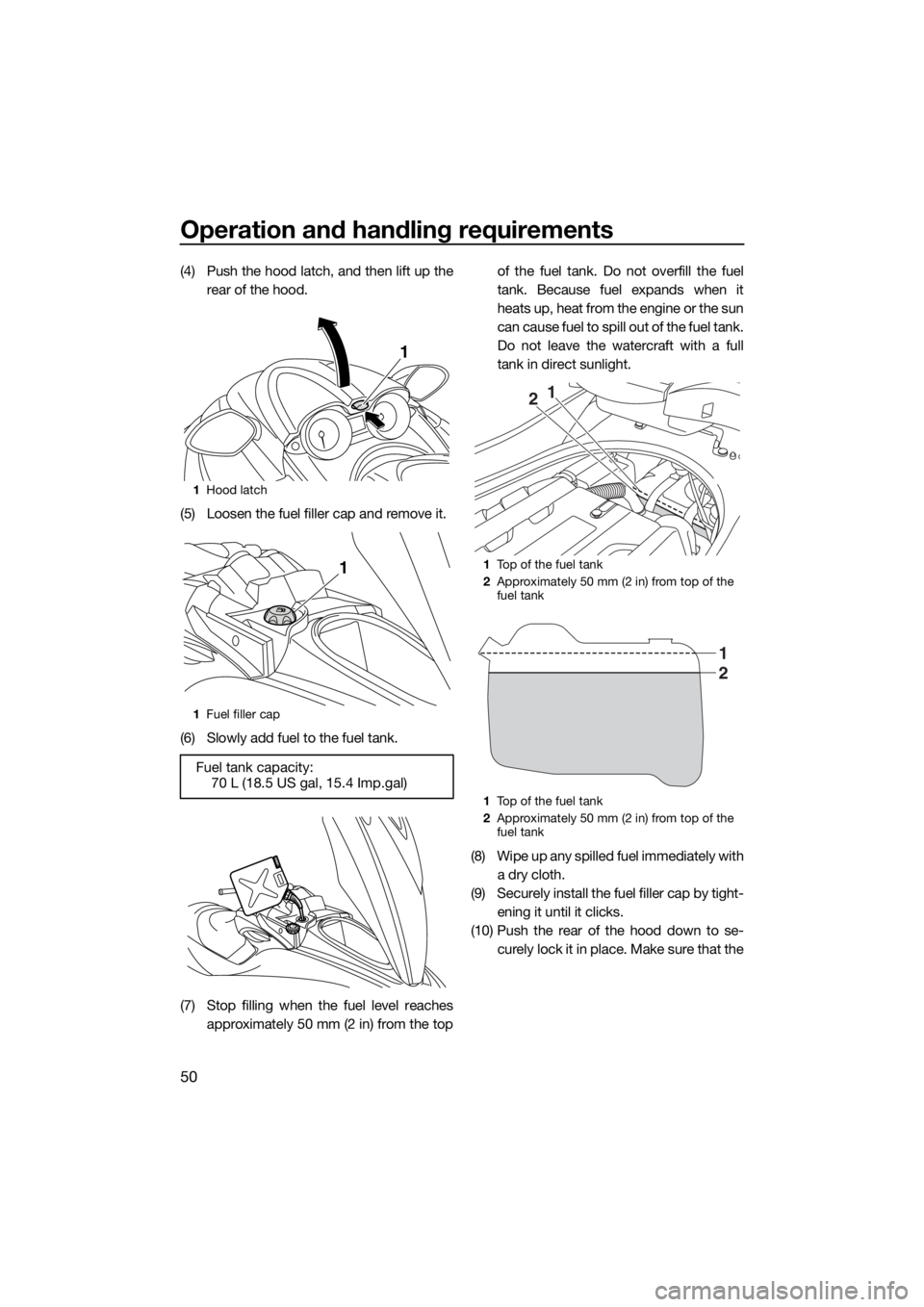
Operation and handling requirements
50
(4) Push the hood latch, and then lift up the
rear of the hood.
(5) Loosen the fuel filler cap and remove it.
(6) Slowly add fuel to the fuel tank.
(7) Stop filling when the fuel level reaches
approximately 50 mm (2 in) from the topof the fuel tank. Do not overfill the fuel
tank. Because fuel expands when it
heats up, heat from the engine or the sun
can cause fuel to spill out of the fuel tank.
Do not leave the watercraft with a full
tank in direct sunlight.
(8) Wipe up any spilled fuel immediately with
a dry cloth.
(9) Securely install the fuel filler cap by tight-
ening it until it clicks.
(10) Push the rear of the hood down to se-
curely lock it in place. Make sure that the
1Hood latch
1Fuel filler cap
Fuel tank capacity:
70 L (18.5 US gal, 15.4 Imp.gal)
1
11Top of the fuel tank
2Approximately 50 mm (2 in) from top of the
fuel tank
1Top of the fuel tank
2Approximately 50 mm (2 in) from top of the
fuel tank
1
2
1
2
UF3K72E0.book Page 50 Thursday, July 16, 2015 2:31 PM
Page 57 of 106
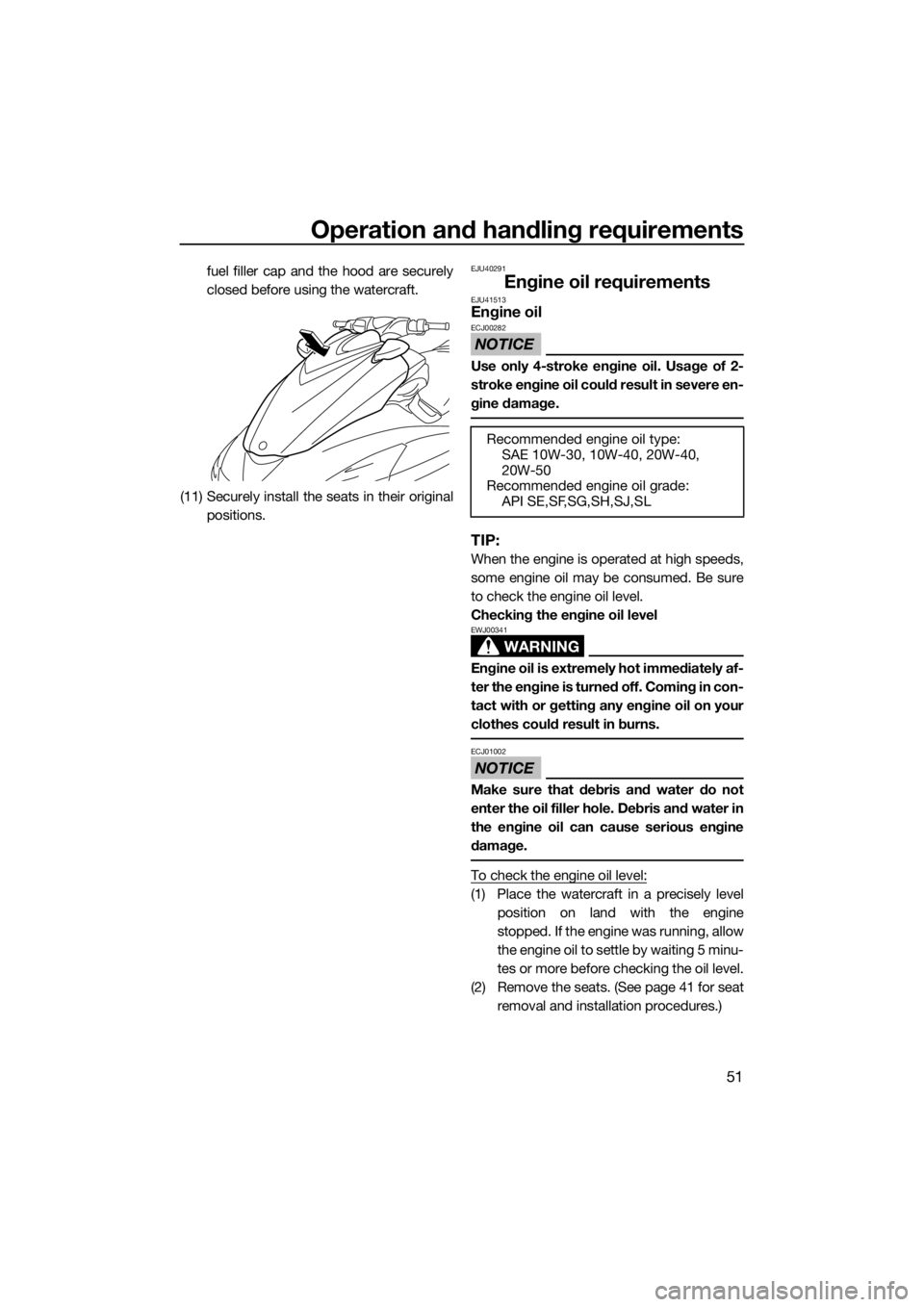
Operation and handling requirements
51
fuel filler cap and the hood are securely
closed before using the watercraft.
(11) Securely install the seats in their original
positions.EJU40291
Engine oil requirementsEJU41513Engine oil
NOTICE
ECJ00282
Use only 4-stroke engine oil. Usage of 2-
stroke engine oil could result in severe en-
gine damage.
TIP:
When the engine is operated at high speeds,
some engine oil may be consumed. Be sure
to check the engine oil level.
Checking the engine oil level
WARNING
EWJ00341
Engine oil is extremely hot immediately af-
ter the engine is turned off. Coming in con-
tact with or getting any engine oil on your
clothes could result in burns.
NOTICE
ECJ01002
Make sure that debris and water do not
enter the oil filler hole. Debris and water in
the engine oil can cause serious engine
damage.
To check the engine oil level:
(1) Place the watercraft in a precisely level
position on land with the engine
stopped. If the engine was running, allow
the engine oil to settle by waiting 5 minu-
tes or more before checking the oil level.
(2) Remove the seats. (See page 41 for seat
removal and installation procedures.)
Recommended engine oil type:
SAE 10W-30, 10W-40, 20W-40,
20W-50
Recommended engine oil grade:
API SE,SF,SG,SH,SJ,SL
UF3K72E0.book Page 51 Thursday, July 16, 2015 2:31 PM
Page 62 of 106
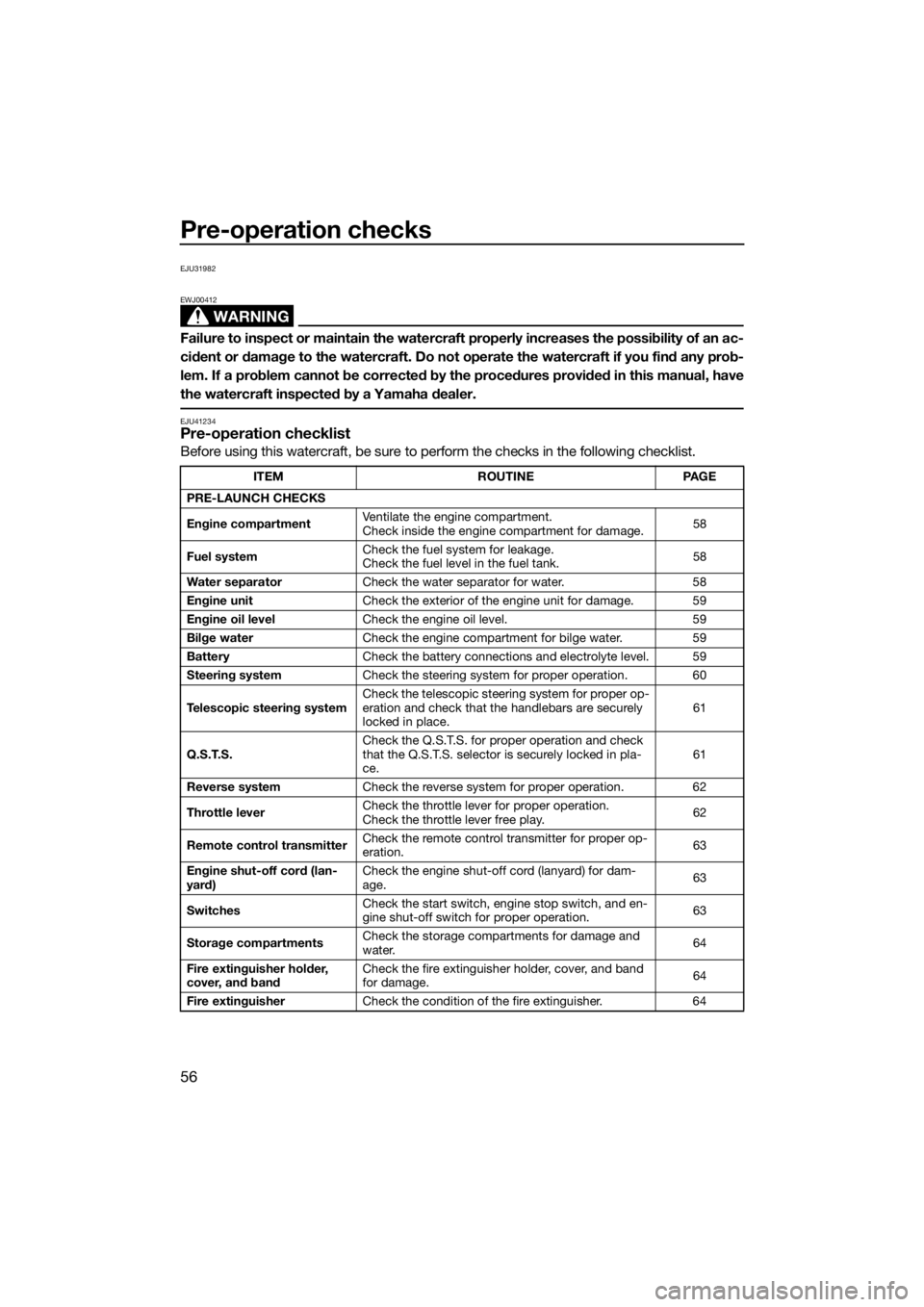
Pre-operation checks
56
EJU31982
WARNING
EWJ00412
Failure to inspect or maintain the watercraft properly increases the possibility of an ac-
cident or damage to the watercraft. Do not operate the watercraft if you find any prob-
lem. If a problem cannot be corrected by the procedures provided in this manual, have
the watercraft inspected by a Yamaha dealer.
EJU41234Pre-operation checklist
Before using this watercraft, be sure to perform the checks in the following checklist.
ITEM ROUTINE PAGE
PRE-LAUNCH CHECKS
Engine compartmentVentilate the engine compartment.
Check inside the engine compartment for damage.58
Fuel systemCheck the fuel system for leakage.
Check the fuel level in the fuel tank.58
Water separatorCheck the water separator for water. 58
Engine unitCheck the exterior of the engine unit for damage. 59
Engine oil levelCheck the engine oil level. 59
Bilge waterCheck the engine compartment for bilge water. 59
BatteryCheck the battery connections and electrolyte level. 59
Steering systemCheck the steering system for proper operation. 60
Telescopic steering systemCheck the telescopic steering system for proper op-
eration and check that the handlebars are securely
locked in place.61
Q.S.T.S.Check the Q.S.T.S. for proper operation and check
that the Q.S.T.S. selector is securely locked in pla-
ce.61
Reverse systemCheck the reverse system for proper operation. 62
Throttle leverCheck the throttle lever for proper operation.
Check the throttle lever free play.62
Remote control transmitterCheck the remote control transmitter for proper op-
eration.63
Engine shut-off cord (lan-
yard)Check the engine shut-off cord (lanyard) for dam-
age.63
SwitchesCheck the start switch, engine stop switch, and en-
gine shut-off switch for proper operation.63
Storage compartmentsCheck the storage compartments for damage and
water.64
Fire extinguisher holder,
cover, and bandCheck the fire extinguisher holder, cover, and band
for damage.64
Fire extinguisherCheck the condition of the fire extinguisher. 64
UF3K72E0.book Page 56 Thursday, July 16, 2015 2:31 PM
Page 64 of 106
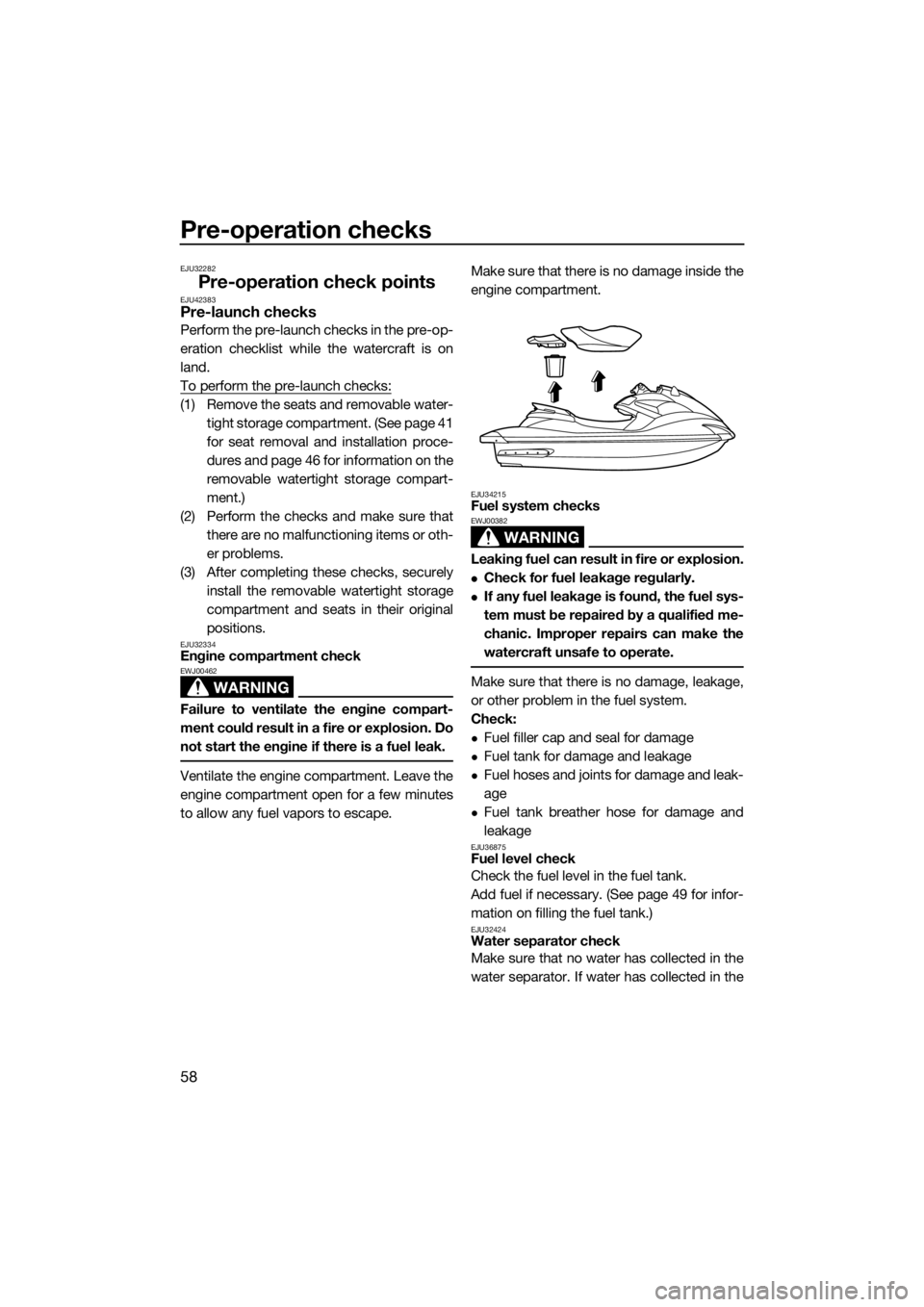
Pre-operation checks
58
EJU32282
Pre-operation check pointsEJU42383Pre-launch checks
Perform the pre-launch checks in the pre-op-
eration checklist while the watercraft is on
land.
To perform the pre-launch checks:
(1) Remove the seats and removable water-
tight storage compartment. (See page 41
for seat removal and installation proce-
dures and page 46 for information on the
removable watertight storage compart-
ment.)
(2) Perform the checks and make sure that
there are no malfunctioning items or oth-
er problems.
(3) After completing these checks, securely
install the removable watertight storage
compartment and seats in their original
positions.
EJU32334Engine compartment check
WARNING
EWJ00462
Failure to ventilate the engine compart-
ment could result in a fire or explosion. Do
not start the engine if there is a fuel leak.
Ventilate the engine compartment. Leave the
engine compartment open for a few minutes
to allow any fuel vapors to escape.Make sure that there is no damage inside the
engine compartment.
EJU34215Fuel system checks
WARNING
EWJ00382
Leaking fuel can result in fire or explosion.
Check for fuel leakage regularly.
If any fuel leakage is found, the fuel sys-
tem must be repaired by a qualified me-
chanic. Improper repairs can make the
watercraft unsafe to operate.
Make sure that there is no damage, leakage,
or other problem in the fuel system.
Check:
Fuel filler cap and seal for damage
Fuel tank for damage and leakage
Fuel hoses and joints for damage and leak-
age
Fuel tank breather hose for damage and
leakage
EJU36875Fuel level check
Check the fuel level in the fuel tank.
Add fuel if necessary. (See page 49 for infor-
mation on filling the fuel tank.)
EJU32424Water separator check
Make sure that no water has collected in the
water separator. If water has collected in the
UF3K72E0.book Page 58 Thursday, July 16, 2015 2:31 PM
Page 85 of 106
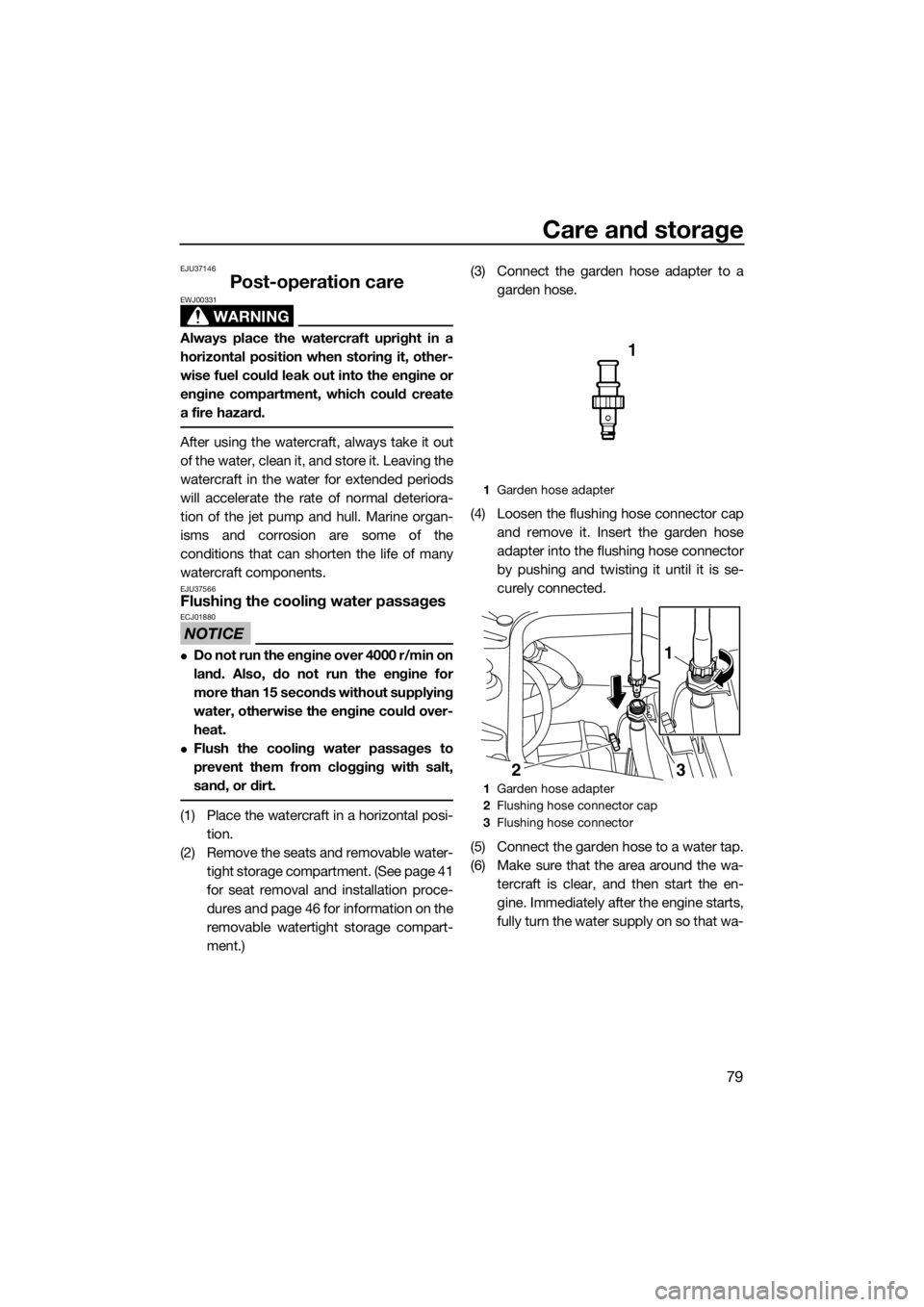
Care and storage
79
EJU37146
Post-operation care
WARNING
EWJ00331
Always place the watercraft upright in a
horizontal position when storing it, other-
wise fuel could leak out into the engine or
engine compartment, which could create
a fire hazard.
After using the watercraft, always take it out
of the water, clean it, and store it. Leaving the
watercraft in the water for extended periods
will accelerate the rate of normal deteriora-
tion of the jet pump and hull. Marine organ-
isms and corrosion are some of the
conditions that can shorten the life of many
watercraft components.
EJU37566Flushing the cooling water passages
NOTICE
ECJ01880
Do not run the engine over 4000 r/min on
land. Also, do not run the engine for
more than 15 seconds without supplying
water, otherwise the engine could over-
heat.
Flush the cooling water passages to
prevent them from clogging with salt,
sand, or dirt.
(1) Place the watercraft in a horizontal posi-
tion.
(2) Remove the seats and removable water-
tight storage compartment. (See page 41
for seat removal and installation proce-
dures and page 46 for information on the
removable watertight storage compart-
ment.)(3) Connect the garden hose adapter to a
garden hose.
(4) Loosen the flushing hose connector cap
and remove it. Insert the garden hose
adapter into the flushing hose connector
by pushing and twisting it until it is se-
curely connected.
(5) Connect the garden hose to a water tap.
(6) Make sure that the area around the wa-
tercraft is clear, and then start the en-
gine. Immediately after the engine starts,
fully turn the water supply on so that wa-
1Garden hose adapter
1Garden hose adapter
2Flushing hose connector cap
3Flushing hose connector
231
UF3K72E0.book Page 79 Thursday, July 16, 2015 2:31 PM
Page 89 of 106
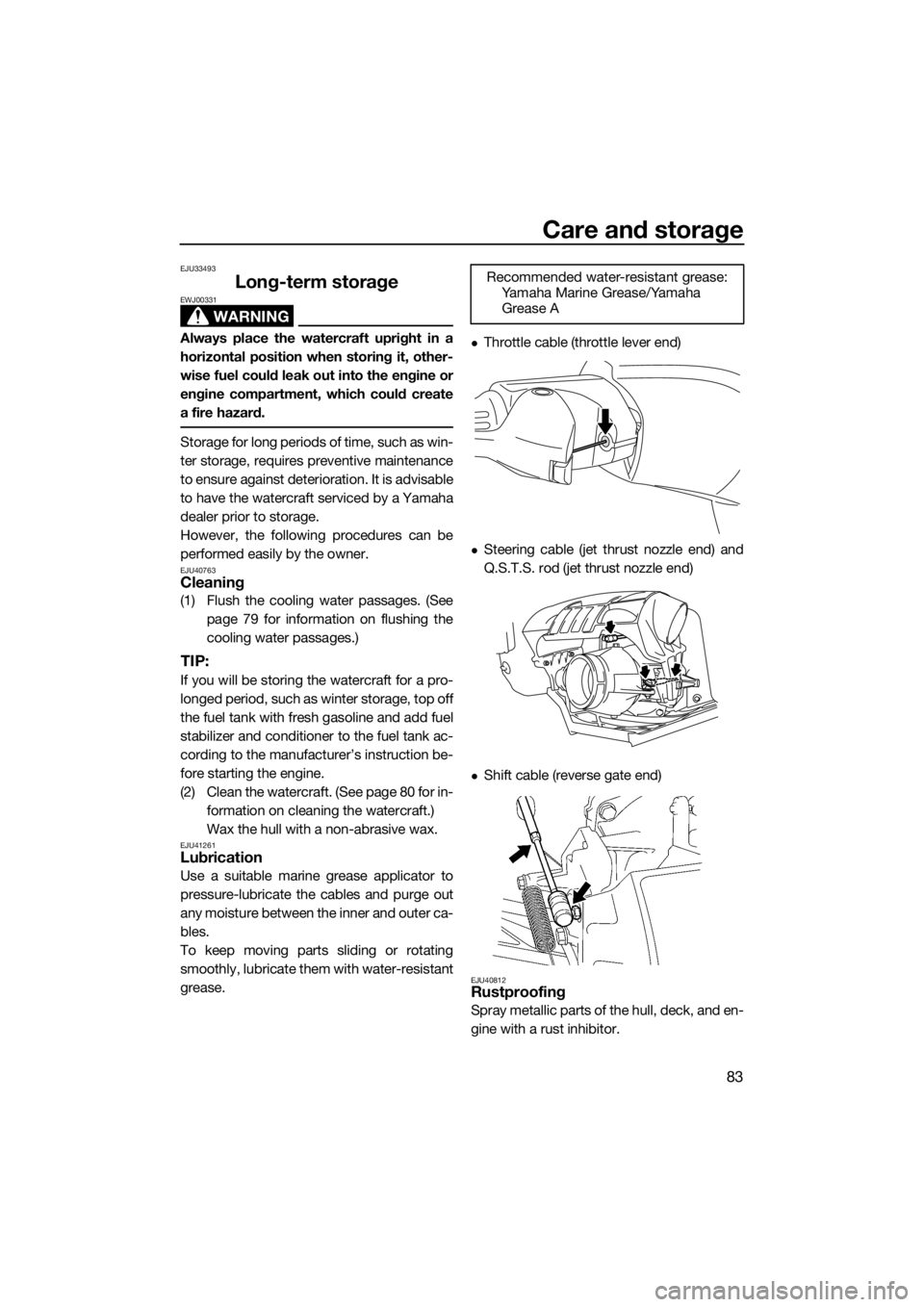
Care and storage
83
EJU33493
Long-term storage
WARNING
EWJ00331
Always place the watercraft upright in a
horizontal position when storing it, other-
wise fuel could leak out into the engine or
engine compartment, which could create
a fire hazard.
Storage for long periods of time, such as win-
ter storage, requires preventive maintenance
to ensure against deterioration. It is advisable
to have the watercraft serviced by a Yamaha
dealer prior to storage.
However, the following procedures can be
performed easily by the owner.
EJU40763Cleaning
(1) Flush the cooling water passages. (See
page 79 for information on flushing the
cooling water passages.)
TIP:
If you will be storing the watercraft for a pro-
longed period, such as winter storage, top off
the fuel tank with fresh gasoline and add fuel
stabilizer and conditioner to the fuel tank ac-
cording to the manufacturer’s instruction be-
fore starting the engine.
(2) Clean the watercraft. (See page 80 for in-
formation on cleaning the watercraft.)
Wax the hull with a non-abrasive wax.
EJU41261Lubrication
Use a suitable marine grease applicator to
pressure-lubricate the cables and purge out
any moisture between the inner and outer ca-
bles.
To keep moving parts sliding or rotating
smoothly, lubricate them with water-resistant
grease.
Throttle cable (throttle lever end)
Steering cable (jet thrust nozzle end) and
Q.S.T.S. rod (jet thrust nozzle end)
Shift cable (reverse gate end)
EJU40812Rustproofing
Spray metallic parts of the hull, deck, and en-
gine with a rust inhibitor.Recommended water-resistant grease:
Yamaha Marine Grease/Yamaha
Grease A
UF3K72E0.book Page 83 Thursday, July 16, 2015 2:31 PM
Page 93 of 106

Maintenance
87
EJU43101Periodic maintenance chart
The periodic maintenance chart gives general guidelines for periodic maintenance. Have a
Yamaha dealer perform the checks in the following chart. However, maintenance may need
to be performed more frequently depending on your operating conditions. If you have any
questions, consult a Yamaha dealer.
This “√” mark indicates items to be checked and serviced by a Yamaha dealer.
Item OperationInitial Thereafter every
Page
10 hours50 hours
or 12
months
*1100
hours or
12
months
*1200
hours or
24
months
*1
Fuel lineCheck fuel hoses and
clamps√—
Fuel filler cap/Wa-
ter separatorCheck O-rings for cracks
and deformation√—
Fuel tankCheck installation and
straps√—
Water inlet strainerCheck for clogs and dam-
age√—
Cooling water hos-
esCheck for damage and
leakage, and check
clamps√—
Engine oilReplace√√89
Oil filterReplace√89
Intermediate hous-
ingLubricate√—
Spark plugsCheck√√—
BatteryCheck state of charge,
terminals, bands, and
breather hose√—
Battery leadsCheck terminals√—
Steering masterCheck operation and for
looseness√√—
Steering cableCheck exterior and con-
nections, and lubricate√—
Q.S.T.S. cableCheck exterior and con-
nections, and lubricate√—
Q.S.T.S. converter
and rodCheck exterior and con-
nections, and lubricate√√—
Shift leverCheck exterior and con-
nections, and lubricate√—
Shift cable and re-
verse gateCheck exterior and con-
nections, and lubricate
√—
UF3K72E0.book Page 87 Thursday, July 16, 2015 2:31 PM
Page 96 of 106

Specifications
90
EJU34543
Specifications
Watercraft capacity:
Maximum people on board:
3 person
Maximum load capacity:
240 kg (530 lb)
Dimensions and weight:
Length:
3370 mm (132.7 in)
Width:
1230 mm (48.4 in)
Height:
1160 mm (45.7 in)
Dry weight:
361 kg (796 lb)
Performance:
Maximum output (according to ISO 8665/SAE
J1228):
183.9 kW at 7500 r/min
Maximum fuel consumption:
76.7 L/h (20.2 US gal/h, 16.9 Imp.gal/h)
Cruising range at full throttle:
0.91 hour
Trolling speed:
1250 ±100 r/min
Engine:
Engine type:
Liquid cooled 4-stroke, DOHC
Number of cylinders:
4
Engine displacement:
1812 cm³
Bore × stroke:
86.0 × 78.0 mm (3.39 × 3.07 in)
Compression ratio:
8.5 : 1
Valve clearance-intake (cold):
0.14–0.23 mm (0.0055–0.0091 in)
Valve clearance-exhaust (cold):
0.36–0.45 mm (0.0142–0.0177 in)
Lubrication system:
Wet sump
Cooling system:
Water
Starting system:
Electric
Ignition system:
T.C.I.Spark plug (NGK):
LFR7A
Spark plug gap:
0.8–0.9 mm (0.031–0.035 in)
Battery capacity:
12 V, 19 Ah
Charging system:
Flywheel magneto
Drive unit:
Propulsion system:
Jet pump
Jet pump type:
Axial flow, single stage
Impeller rotation:
Counterclockwise
Jet thrust nozzle angle:
24+24 °
Jet thrust nozzle trim angle:
-10, -5, 0, 5, 10 °
Fuel and oil:
Recommended fuel:
Premium unleaded gasoline
Minimum octane rating (PON):
91
Minimum octane rating (RON):
95
Recommended engine oil:
YAMALUBE 4W or 4-stroke motor oil
Recommended engine oil type SAE:
SAE 10W-30, 10W-40, 20W-40, 20W-50
Recommended engine oil grade API:
API SE,SF,SG,SH,SJ,SL
Fuel tank total capacity:
70 L (18.5 US gal, 15.4 Imp.gal)
Engine oil quantity with oil filter replacement:
3.6 L (3.81 US qt, 3.17 Imp.qt)
Engine oil quantity without oil filter replacement:
3.5 L (3.70 US qt, 3.08 Imp.qt)
Engine oil total quantity:
5.3 L (5.60 US qt, 4.66 Imp.qt)
UF3K72E0.book Page 90 Thursday, July 16, 2015 2:31 PM
Page 97 of 106

Trouble recovery
91
EJU34562
Troubleshooting
If you have any trouble with your watercraft, use the troubleshooting chart to check for the
possible cause.
If you cannot find the cause, consult a Yamaha dealer.
EJU36987Troubleshooting chart
Confirm the possible cause and remedy, and then refer to the applicable page.
TROUBLE POSSIBLE CAUSE REMEDY PAGE
Engine does not
start (Starter motor
does not turn over)Ya m a h a S e -
curity SystemLock mode selected Select unlock mode
27
Engine shut-
off switchClip not in place Install clip
28
Fuse Burned out Replace fuse and
check wiring95
Battery Run down Recharge 80
Poor terminal con-
nectionsTighten as required
80
Terminal corroded Clean or replace 80
Starter motor Faulty Have serviced by
Yamaha dealer—
Engine does not
start (Starter motor
turns over)Throttle lever Squeezed Release 28
Fuel Fuel tank empty Refill as soon as pos-
sible49
Stale or contaminat-
edHave serviced by
Yamaha dealer—
Fuel tank Water or dirt present Have serviced by
Yamaha dealer—
Spark plug Fouled or defective Have serviced by
Yamaha dealer—
Fuel injec-
tion systemFuel pump faulty Have serviced by
Yamaha dealer—
UF3K72E0.book Page 91 Thursday, July 16, 2015 2:31 PM
Page 98 of 106

Trouble recovery
92
Engine runs irregu-
larly or stallsFuel Fuel tank empty Refill as soon as pos-
sible49
Stale or contaminat-
edHave serviced by
Yamaha dealer—
Incorrect octane
numberUse correct fuel
49
Fuel tank Water or dirt present Have serviced by
Yamaha dealer—
Spark plug Fouled or defective Have serviced by
Yamaha dealer—
Incorrect heat range Have serviced by
Yamaha dealer—
Gap incorrect Have serviced by
Yamaha dealer—
Electrical wir-
ingLoose connection Have serviced by
Yamaha dealer—
Fuel injec-
tion systemFaulty or clogged in-
jectorsHave serviced by
Yamaha dealer—
Warning light or in-
dicator blinks or
comes onFuel level
warningFuel tank empty Refill as soon as pos-
sible49
Oil pressure
warningOil pressure dropped Have serviced by
Yamaha dealer38
Engine over-
heat warningJet intake clogged Clean
94
Check en-
gine warningFaulty sensors Have serviced by
Yamaha dealer39 TROUBLE POSSIBLE CAUSE REMEDY PAGE
UF3K72E0.book Page 92 Thursday, July 16, 2015 2:31 PM